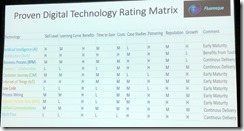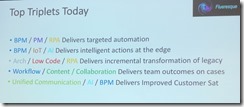Note that Kris Verlaenen, jBPM project lead at Red Hat, is also blogging from here, check out his coverage for a different view.
Democratizing Machine Learning with BPM, by Scott Menter and Joby O’Brien of BP Logix
We’re now into the full demo sessions at bpmNEXT, and Scott and Joby are up to talk about they’re making machine learning more accessible to non-data scientists and integrating it into their BPM tool, Process Director. They do this by creating a learner object that pulls in data from an external source, then configure the system to select the predicted data field, the algorithm to use and the input data feature to use for prediction. Their example is whether an employee is at risk for leaving the company (possibly a gentle dig at a bigger company making the same sort of predictions), so select one or more input values from the employee data set such as amount of travel and income. They have some nice visualization tools to use while building the learner object, selecting a couple of input features to see which may be the most interesting in the prediction, then can create the learner object so that it can update forms as data is entered, such as during a performance review. This now allows the output from a fairly sophisticated ML object that is analyzing past data to be used just like any other rule or data source in their BPMS. In general, their tools can be used by someone who knows about data scientists to create learner objects for other people to consume in their processes, but can also be used for those without a lot of data science knowledge to create simple but powerful machine learning predictions on their own.
Leveraging Process Mining to Enable Human and Robot Collaboration, by Michal Rosik of Minit
Michal started with the analysis of an invoice approval process as seen through their process mining tool, but the point of his demo was to perform data mining on UI session recording data, that is, the data collected when a recorder is monitoring a person’s activities to figure out exactly the steps they are taking to perform a task. Unlike a strict RPA training/scripting session, this can use data from users just doing their day-to-day work, filter out the activities that aren’t related to the task, and create a definition of the best RPA path. Or, it can use data from the process when RPA is performing the tasks to see where there are potential problems within the bot’s actions or if the existence of the bot is causing bottlenecks to be shifted to other parts of the process. It can use process variant analysis to look at the differences between the process pre- and post-bot implementation. He also showed their Minit dashboard, being released now, which combines process mining and business intelligence to see a much more predictive environment for business managers.
Process Mining and DTO — How to Derive Business Rules and ROI from the Data, with Massimiliano Delsante and Luca Fontanili of Cognitive Technology
DTO – the digital twin of an organization – is the focus of Massimiliano and Luca’s presentation, and how to get from process mining to DTO for analyzing and governing processes in their myInvenio tool. From their process mining model, they can show a number of visualizations: non-conformant cases within the process, manual steps (not yet automated, showing potential for improvement), steps that are in violation of their SLA, and a dashboard combining activity cost and other performance data with the process mining model. They demonstrated how a reference model would be created using BPMN and DMN to allow conformance checking and simulation, or derive the BPMN model – including branching rules – directly from the discovered process model. They’re using machine learning to discover the correlation from which the branching conditions are determined, but the business user/analyst can override the discovered branching rules to define more precise decision rules and decision tables. This “decision mining” is a unique capability in the process mining world (for now). The analyst can also add manual steps to the discovered process model in BPMN mode, which will update the related analytics and visualizations. Their simulation allows each step to not just be simulated as it is currently, but by specifying potential robot replacements of some of the human operators at an activity, comparing the different scenarios.
As a comment on the latter two process mining sessions, I’m really happy to see process mining moving from a purely post-execution analytical tool to an interactive process health check and prediction tool. I’ve done some presentations in the past in which I suggested that process mining would be a great tool for forward-looking simulations and what-if scenarios, and there’s so much more than can be done in this area.


